
|


|

|

|

|

|
Z Score Biofeedback has Transformed
the
Field of Neurofeedback
What Our Clinicians Say about
Using NeuroGuide and Neurofeedback...
|
NeuroGuide Z-Score training and the Symptom
Checklist training have resulted in substantial improvement in
patients. For example, a stroke victim who after just 3 full cap
coherence sessions regained use of his arm and was able to close his hand as if
holding a baseball or a chronically depressed woman who after just two full cap
sessions claimed she felt like new person; and, another chronically anxious
woman who stated she wanted as much of this stuff as she could get because she
felt so good. Quite honestly, I have never seen this kind of rapid
progress in certain patients with any other training format. My guess is
you have taken neurofeedback training to a "new level."
Robert McCarthy, Ph.D. McCarthy Counseling Associates,
PA |
|
Attached is a summary of seven sessions of LNFB training with a young Marine
combat veteran. Importantly, he is no longer taking any psychotropic medications and is
going to start school next week. He told me today that he was feeling different
but didn't know what to attribute it to. I showed him the session progress
screen and his eyes welled up and said, "I guess I am better." I think
he is too. Thanks for giving me the tools to help this youngster - as a retired
Marine, being able to offer healing and hope to these kids is a big deal to me.
Have a great week end.
Wesley
D.
Center
, PhD, LPC-S,
NCC
, BCPCC
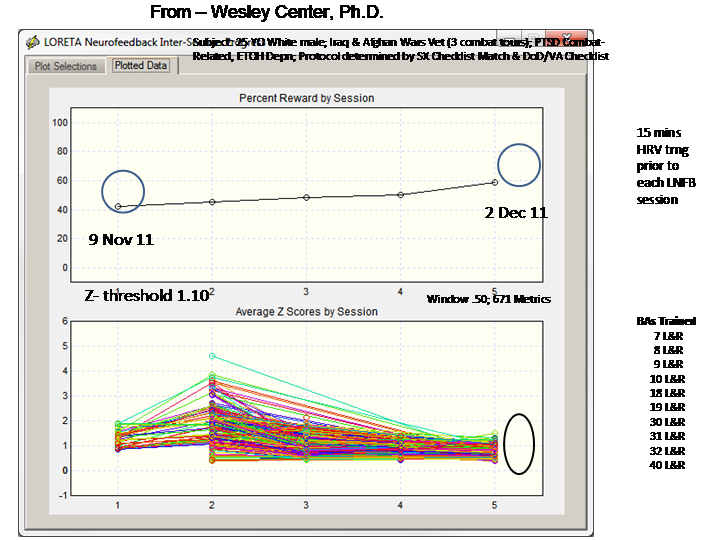
|
|
I wanted to thank you for
the opportunity to use Z score training. I have worked for ten years in
neurofeedback and, while I have had good results, they do not compare to what I
am getting now. Many of my patients report an immediate sense of calm when they
are experiencing Z score training. It is as if the request that the
brain communicate with itself better can be a much better challenge than asking
the brain to improve at one or even two sites. My younger patients are
often able to tolerate sitting still for the training because they feel immediately
better and they want that feeling to continue. They complain of boredom much
less often. Thanks again for your work. I feel Z score training is a big
step toward helping to improve brains, one brain at a time.
Sincerely,
Kym Crown
|
I have put the surface
Neurofeedback in use strait away and it seems to be an extremely valuable
addition. I am also getting the first modest results with LORETA
Z-scores from one of my cleints who spent decades in therapy and was barely
functional and is back to the Gym and full of new ideas and clarity that he
professes not to have experienced for many years.
|
|
Bob and Applied Neuroscience:
The
parents of this young lady are pleased with a number of positive behaviors and
overall attitude of their daughter.
This is a progress map of a 12 year old girl with generalized anxiety
who has a traumatic background. She
started out having psychotherapy sessions for about 6 months and then began 19
Channel Surface Neurofeedback.
Her clinical symptoms were: irritability,
lack of focus and concentration, sadness, nightmares and anxiety.
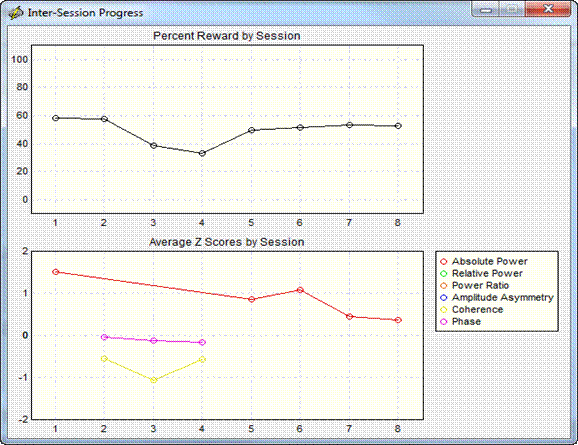
After 8 sessions, Her parents report that she has
improved her grades, is doing better with her homework, is less irritable,
more sociable at home with family members, has a significant decrease in
nightmares and appears to be handling stress (mostly school and peers) much
better.
Many thanks again for helping me to help my clients.
Lea Leonard, LCSW, CTS, BCN
Naples, FL 34103
|
|
Many thanks for all you have contributed to the
field and especially to my clients.
Including the addition of your recommendations
from the qEEG's I send you, over 90% of my veterans of police service reach
remission of their DSM-IV duty-related PTSD symptoms. They still require
follow-up sessions including NF refresher which serves to pretty much eliminate
any relapse and also help them get on with their lives. This is truly
remarkable given the number, intensity, and duration of PTSD symptoms they come
with, the large number of significant accumulated traumatic experiences they
have had, the number of co-morbid conditions accompanying the PTSD, and how
badly many have been treated by police management.
Hats off to you and personal regards
John Carmichael, Ph.D.
_______________________________________________________________________________________________
I Thought you might like to know last week did
my first phase shift session with an autism spectrum teenager. Following week,
last night, mother came in and said what did you do. Claimed her daughter was
more conforming of requests and talked twice as much as ever before. I've worked
with her for months, and while making progressing, have not seen this type of
"step up" until now.
Very interesting and exciting.
Robert McCarthy, Ph.D.
|
|
I am very excited about this: my 17 year old client has suffered from a lot
of mental challenges. One that has lingered is amblyopia and a serious
divergent strabismus. We tried developmental optometry for years: eye
patching, eye exercises, etc., along with traditional NFB. But he
continued to be monocular and one eye was shutting down which I verified by
looking at his visal corrtex. Last year he had eye surgery and the
surgeon said that he would never have binocular vision because it was "too
late". Although his eyes were 'pulled together' he was still only
seeing with one eye post surgery. I did several sessions of LORETA and
surface Z score training the past two months and last week he put 3D glasses on
while looking at a 3D TV at best buy and he said "I can see 3D, I've never
been able to before!" We verified this and this of course
indicates that he is seeing binocular? He is shooting baskets in
basketball like I have never seen too ... this is amazing.
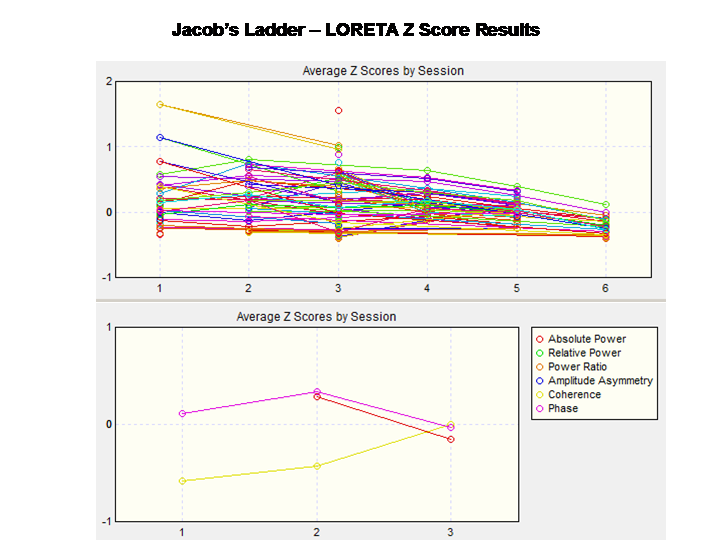
Thanks,
Wuttke, Executive Director, Wuttke Insittute |
|
Without your work all this would not be
possible. Z-score NF is really great, it is helpful in so many cases - and I
hear a lot of good reports from my workshop attendees. The approach isn´t too
hard to understand and also its not too hard to teach to somebody. Good results
can be made by everybody who really wants to learn. The fascinating thing is
also when I feel that I also can be a part of this wonderful development.
Thomas Feiner, Ph.D.
|
|
While
I knew your new program would be good, I
had to share my excitement and
enthusiasm. Most impressive is the manner in which you
incorporated the technical sophistication of Neuroguide that already
exists, with the simplicity of
clinical use. In essence, a breath of fresh air in an otherwise sometimes
cumbersome and overwhelming technological world.
Despite the tremendous breadth and depth of being able to interface
with Neuroguide in so many ways, it [LORETA Z score biofeedback] can be
easily learned by novices and experienced
practitioners alike in just a few hours. Now pre and post session data can even
be converted into pre and post session brain
maps, and coherence changes carefully monitored from training
session to training session. Quite honestly, this is one of the most
exciting developments I have come across since entering the
neurofeedback field some twenty years ago.
Again,
congratulations to you and your developers on a fantastic piece of work!
Robert
McCarthy, Ph.D., Clinical Psychologist, Myrtle Beach, SC |
|
I have been using Neuroguide’s Z Score surface program for approximately 7
months and have been very impressed with the results.
The following is a case of a 50 year old female who came to me in June of
2010 with major depressive DO even while medicated she had frequent bouts of
crying, thoughts of suicide and days she could not get out of bed.
She was under a great deal of stress, separated from her husband and had
a very stressful job. Her
medications were 225mg Effexor XR; 175mg of Wellbutrin and 1.5mg of Clonozepam.

She began 19 Channel Surface Z Score Neurofeedback in
August of 2011, she was in a much more stable place and able to cope with
stressful situations. At the time of
her first Neurofeedback session she had titrated down to 75mg of Wellbutrin and
was going to continue to come off of that medication.
Since then she has titrated down to 1mg of clonozepam and continues to
take 225mg Effexor.
She has shown remarkable improvement in her mood and her
ability to cope with stress. Today
she feels that she does not need medication and will work with her Psychiatrist
to titrate down the dosages of remaining Effexor and Clonozepam – her goal is
to become medication free. She does
understand that that may not be possible, however, she is willing to settle with
much less medic ation if she needs to.
Her Neurofeedback protocol began with Absolute Power, Phase
and Coherence working to bring 3+ Z scores to zero.
She began to feel much calmer at 4 sessions. At
13 sessions she had cut clonozepam to 1mg from 1.5 and was completely off of
Wellbutrin. She states that for the
first time in 15 years she really feels her emotions, instead of a “numb or
fog” feeling.
Along with her continued therapy and Neurofeedback
sessions, she filled out the Walmyr self report tools:
Generalized Contentment Scale and the Index of Clinical Stress.
See below the continued improvement in both – she no longer meets
criteria for either clinical condition.
My thanks and appreciation for all of your hard work to
help me help my clients!!
Lea Leonard, LCSW, CTS, BCN
|
|
Hi Bob,
This is a 25 year old female in her final
year of law school. Her reported symptoms were anxiety, depression and
attention deficits. Based on history and additional testing the latter
seemed to be secondary to anxiety. She received 13 sessions of
LORETA
NF
using the Symptom Checklist. She gradually reported lower anxiety/depression
and better ability to focus and attend. She had been very worried about
her ability to study for her final exams. She did very well in fact and is
now articling with a quite prestigious law firm. I would likely have
continued for a few more sessions but she is no longer living in
Victoria
. She will return for bi or tri weekly sessions if she feels
she needs to.
Best,
Atholl Malcolm, Ph.D.
Here are pre-treatment qEEG maps
Here are post-treatment qEEG maps
 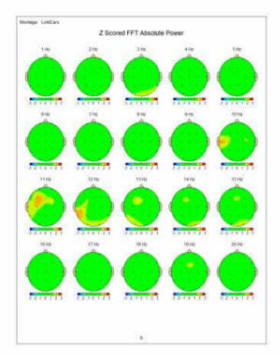 
|
|
I am using Neuroguide Z-Score training more and more with patients. This is primarily due
to the fact that Symptom Checklist Training suggestions have resulted in
substantial clinical improvement with patients.
For example, a stroke victim who after just 3 full cap coherence sessions
regained use of his left arm and was able to close his hand as if holding a
baseball (Continues to improve after 1 month); a chronically depressed woman who
after just two full cap sessions claimed she felt like a new person (No longer
lethargic, unmotivated); and, another chronically anxious woman who stated she
wanted as much of this stuff as she could get because she felt so good (Going
out, no longer hiding in house due to agoraphobia).
I saw an extremely hyperactive boy this afternoon after just 2 full cap sessions
using Symptom Checklist recommendations. His parents and all his teachers asked
what medication he was taking as they never seem him so calm.
Observably, the change was dramatic.
Quite honestly, I have never seen
this kind of rapid progress in certain patients with any other system
of training format. My guess is you have taken neurofeedback training to a
"new level".
-----------------------------------------------------------------------------------------------------------------------------------------------
LORETA Neurofeedback and Neurofield.
The
attached pdf shows the
clients change over several sessions. Each session began with Neurofield and
followed with LORETA Z score neurofeedback. Each session was 1 hour.
The
clients have been very pleased with their progress.
Phil
Jones, Ph.D.
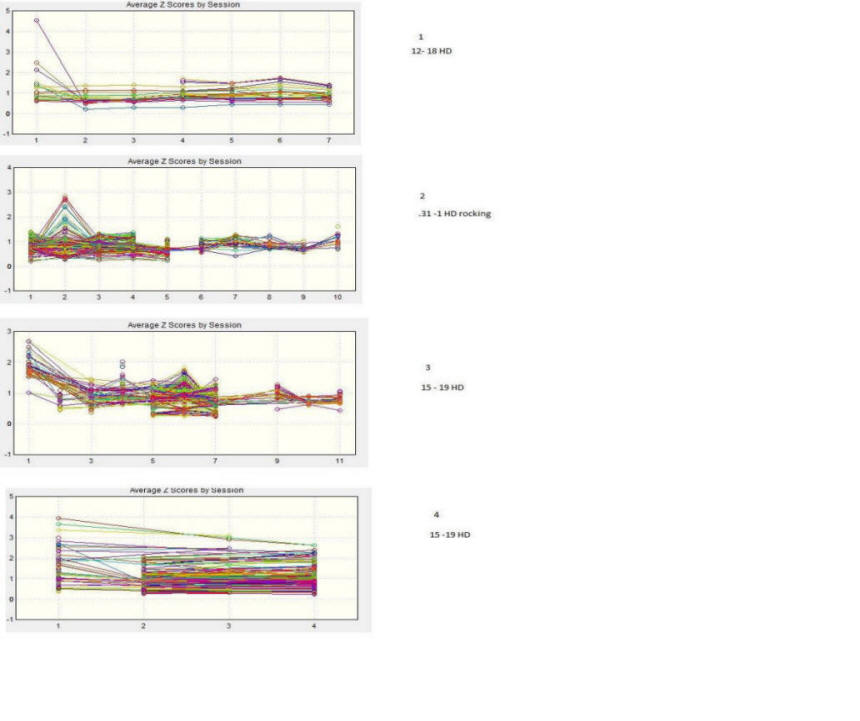 |
|
I
am here in
Cancun
and
have been doing demos for some important people here in
Mexico
and treating a select few folks here with NG LORETA -
I want to give you some
feedback regarding the observations that continue
to mount. First, I believe that what you have done with the software, the
symptom checklist, etc., in the right hands, is one of the biggest breakthroughs
in behavioral medicine - really worth a Nobel prize - and I am not kidding. Over
the past 3 days I have treated anorexia, Autism, seizure disorders, and clinical
depression, all with noticable results within hours of the sessions - the
depression client is astounded, "I feel I am alive again!" (this
statement after one session). I believe your imperative, "Location!
Location! Location!" is paramount as well as following a hierarchy of brain
networks from foundation to higher cortical function. Anyway, I just wanted to
say that I recognize this enormous accomplishment and contribution you have made
and I am confident - more so with every person I treat - that ultimately this
will be a major source of relief for so many - thanks for your good work.
The
Wuttke Institute
________________________________________________________________________________________________
Hi Bob,
This client is
a 57 year man, with a history of anxiety and depression stemming from events
in his developmental years. He is normally very successful in his occupation.
On this occasion he over-extended himself with responsibility and this
resulted in an acute reaction involving anxiety and depression (November
2010). There have been similar episodes in the past, but this is the first
time I have seen him. On presentation in August he had been off work for two
months and unable to get out of bed in the mornings. It should be noted that
he has always had obsessive tendencies.
The first maps
were obtained August 2011, and high power is evident, mainly from 11 to 25 Hz.
(see attached). Coherence and phase were OK. The second maps were taken on
November 23, 2011
after 16 sessions of
LORETA
NF
. It can be seen that the extent of surface high power is significantly
reduced. Other intermediate maps tracked the changes. At that point, it was
decided not to continue with therapy even though there remained some hot areas
because the client had been successfully back to work for a month and was
reporting no discomfort due to anxiety or depression. Also, we discussed the
fact his obsessive tendency was what motivated him at work and led to his
success. Thus, we terminated with the understanding that it his option to
return if symptoms re-emerge. In general we stuck to the adage of matching
symptoms to location. So far, so good.
Best,
Atholl Malcolm,
PH.D.
Pre-Treatment qEEG maps from August 11, 2011 - Symptoms are present
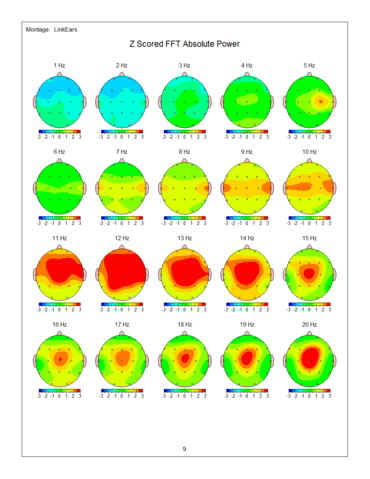 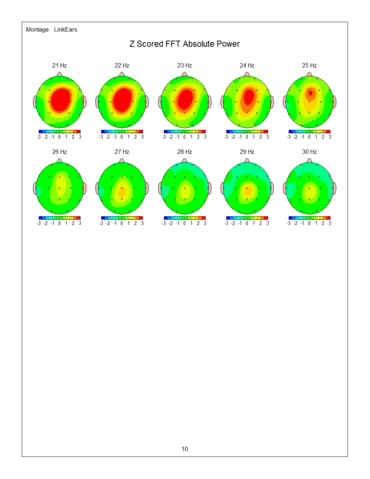
Below
are Post Treatment qEEG maps
November 23, 2011
– Symptoms improved and client was working and functioning well and decided
to terminate treatment.
 
|
|
Graph of Loreta Z score training for 18 year old with high
anxiety associated with history of trauma– for the first time in quite a while
she does NOT wake up feeling nauseous or anxious.

Lea Leonard, LCSW, CTS, BCN
|
|
I
have run a couple of sessions with BrainSurfer. Patients had 6 st. dev. LORETA
Z scores before. They were able to normalize attention and addiction networks
and Delta-Alpha power in less than 30 minutes...WOW! Thanks for the clue on
rotating, and getting Brodmann areas. It is just fabulous to watch metrics
normalize and be able to move to another network live.
Cheers, Grant Bright, Ph.D. |
|
|
|
BOB, YOU AND YOUR TEAM ARE
ABSOLUTELY AWESOME! I AM PROUD TO BE USING THIS INCREDIBLE SOFTWARE. IT'S HAVING
A MAJOR IMPACT ON MY WORK WITH MY CLIENTELE. I HAVE BEEN ENCOURAGING MY
COLLEAGUES TO GET ON THIS RIGHT AWAY!
KINDLY,
SAL BARBA
|
|
You will see the degree of attenuation of beta
with no adverse reactions and clinically according to informants her level of
functioning has improved as has mood stability and decreased reactivity. We
still have a long way to go. This was done with straight LORETA and no other
neuro modulation. She has significant Axis I, II and III difficulties
complicating matters enormously. Shows you the power of LORETA.
Gerald Gluck,Ph.D., LMFT, PA
BCN, (Board Certified In Neurofeedback) Sr.
Fellow |
|
Very good. I
have subjective improvement charted per session with qeeg data for each session.
Of the first 100 I looked at I have 99% positive response (the one non-responder
reported no subjective improvement but objective improvements were visible in
his qEEG data). This is much better than I have gotten with pre-LORETA training.
I had an
interesting testimonial yesterday from a client with a 42 year old brain injury
and left hemiparesis: he looked at me with almost tears in his eyes and said,
after 3 sessions “I was able to walk on the treadmill without holding onto the
handrails for the first time in 42 years. I can plant my heel before my toes for
the first time in 42 years. I can run for the first time in 42 years.” How’s
that for specific, targeted training? I almost cried too.
Dale S Foster,
PhD, QEEGT, BCN Sr Fellow |
|
Thank you for ALL of these
wonderful clinical tools. I have about 20 patients now, and 100% of them are
benefiting significantly. You are helping many people in this world, and you
have helped me change the lives of my clients in ways I didn't know were
possible!!!!
Thank you,
Richard D. Abbey, Ph.D.
Clinical Neuropsychologist
Clinical Psychologist
Abbey Neuropsychology Clinic
366 S. California Ave., Suite 9
Palo Alto, CA
94306 |
|
Just want to pass on to you all that the webinar #10--linking symptom checklist to surface neurofeedback--was a terrific
review of how to conduct the whole process, from client assessment to applying
principles of learning to train most efficiently. I was most interested in
learning just how the NG software assists in that and saw in the demonstration
that it is a seamless process, that's very easy to implement and that follows
all the primary principles of operant conditioning, from assessment and
identifying the target behaviors to effective delivery of reinforcement. Bob
also explained very clearly the rationale of Z-tunes, which I think would be
most useful. All else can be accomplished separately, though less efficiently,
using any assessment procedure and Z score software, but the Z tunes is unique
to NG and seems like it should be particularly useful. If anyone has had
experiences with that I'd appreciate hearing how useful you've found it to be.
I highly recommend this webinar as in an introduction or refresher on all of
these points. Kudos to Bob, yet again!!
Barbara Hammer, Ph.D.
|
|
I have been using QEEG/ Neuroguide since
2010, and I get so much praise and support from attorneys. Attorneys say that my
QEEGs are sometimes the only thing that gives them the edge over their
competitors. Sometimes because of work pressure, or because a patient has an
unsuitable hairstyle for QEEG, I have sent out neuropsychological reports
without a Q. Several attorneys have sent the patients right back with messages
such as “How can you do a report without a QEEG?”.
Dr. Joachim Fl. Mureriwa
|
|
I
have been using the surface Z-score neurofeedback for a few months now and I
just want you to say
that I’m absolutely astonished about the results I
get! I
have been doing a lot of neurofeedback on childeren with autism in a clinical
setting for the last 7 years and have never seen these kind of results before.
Thank you very much for this great software!
Tim Smits
|
|
By the way, your
program is having a big impact on the children and families in Palo Alto. A
young man who recently came to me with symptoms of OCD has already experienced
some symptom relief after only 10 sessions of Loreta neurofeedback! He is no
longer afraid to fly on planes, is not afraid to stay away from home (stayed
away for several days and has never had been away for even a single night
before), and slept 12 hours for the first time in his life (usually sleeps half
this amount at best). You are having a huge, positive impact on the world, and
your program is allowing me and my team to do this one client at a time here in
high tech Palo Alto. The computer engineers love it, because the automatically
get the math (e.g., FFT), and it is a much better fit for most of them rather
than medication.
All my best,
Richard D. Abbey, Ph.D.
Clinical Neuropsychologist
Clinical Psychologist
|
|
Oh by the way –
we love what you’ve done with Brainsurfer. The HMI is much more intuitive and in
keeping with NF2. Being able to capture the session data is also a real benefit.
Brilliant! And thanks!
Wesley D.
Center, PhD, LPC-S, NCC, BCPCC, BCN |
|
I see
a large number of children and use your program, ages 4-15 and I have had solid
and rapid success with most. One little girl went from having severe anxiety,
throwing iPads at the wall and made dramatic changes in 10 sessions. Another,
the son of a vet with PTSD had not gone to school for months because of severe
anxiety and GI issues and while he took a little longer he has since graduated
and 6 months later is still doing well, going to school. His father a gulf war
vet, disabled with PTSD and severe sleep disorder is now doing LORETA
Linda Marshall Kramer, MA
|
|
I cannot
express to you how influential NeuroGuide and your contributions have been to my
life. My son included.
Thanks.
Ken Olson, M.D.
|
|
NeuroGuide
neurofeedback has produced the most amazing results in the shortest possible
time. I must congratulate you on your fine product
Hasan Asif, M.D.
|
|

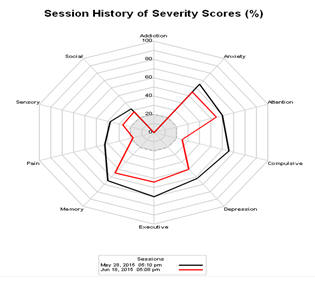
Merlyn
Hurd, Ph.D.
|
|
RR
had clinical symptoms related to a reported diagnosis of early stages of
dementia. RR had trouble recalling words, was exceedingly forgetful, slow with
speech. On 4/10/2015 I performed a QEEG and did LORETA Z Score neurofeedback.
I utilized Neuroguide’s Symptom Checklist (SCL), matching symptoms to his QEEG,
of executive function and working memory problems.
RR
participated in 6 more sessions utilizing Neuroguide’s SCL and NF Tools. The 8th
session we returned to the original protocol based on the SCL of the 5/27/2015
QEEG. RR has shown significant improvement in executive functioning, memory
retrieveal and organization skills as observed and self reported.
This chart shows the
Brodmann areas (BAs) or regions of interest that were targeted during neurofeedback. The top chart shows the percentage of rewards averaged for that
particular session (number of times you could hear the sound and see the
picture). The bottom chart shows the average Z score for each BA
targeted. This particular graph shows areas as high as 3.8 std above the norm –
by the 8th session all areas targeted fell to below 2 std deviations.
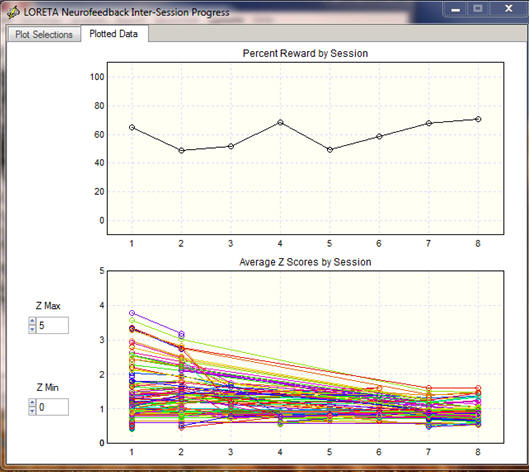
Lea Leonard, LCSW, BCN
|
|
|
|
|
|
|

|
|
